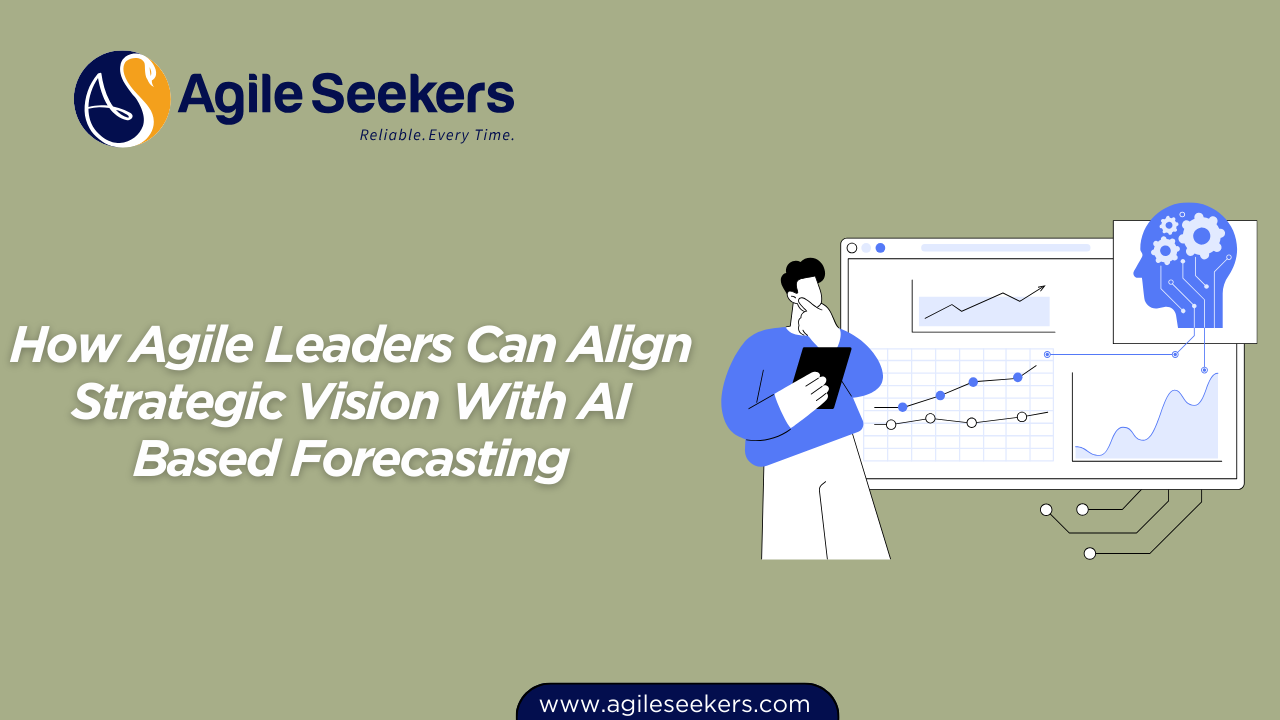How Agile Leaders Can Align Strategic Vision With AI Based Forecasting

Agile leadership thrives on adaptability, but adaptability doesn’t mean guesswork. The best leaders balance long-term vision with near-term insights. That’s where AI-based forecasting steps in. It gives leaders a way to anticipate outcomes, spot risks earlier, and align strategy with execution without losing agility. Let’s break this down in detail.
Why Strategic Vision Needs More Than Instinct
Agile leaders are expected to chart a clear vision, but visions often collapse when they meet the reality of shifting priorities, unpredictable customer behavior, or economic turbulence. Traditional forecasting methods—manual spreadsheets or static reports—fall short because they rely on historical data alone.
AI changes the equation. By blending historical data with real-time signals, machine learning models can project likely scenarios, predict delivery timelines, and uncover hidden risks. This makes forecasting less about gut instinct and more about data-driven confidence.
AI-Based Forecasting: A Practical Fit for Agile Leadership
AI forecasting tools aren’t about replacing human judgment. They’re about augmenting decision-making with sharper insights. Agile leaders can use AI to:
-
Anticipate delivery risks: Predict which initiatives are most likely to slip based on past velocity, dependencies, and resource constraints.
-
Model scenarios: Run simulations to see how shifting resources or reprioritizing features impacts long-term objectives.
-
Balance short-term trade-offs: Use predictive analytics to decide when to pivot, pause, or scale efforts without drifting from the bigger vision.
-
Spot emerging trends: AI can surface customer behavior shifts earlier than traditional market analysis, allowing leaders to align strategy in real time.
For example, a portfolio leader can connect AI-driven forecasts with OKRs to ensure the organization’s investment streams align with strategic intent. This bridges the gap between abstract goals and daily team-level execution.
Aligning Vision with Execution Through AI
Here’s how leaders can actively align their strategic vision with AI forecasting insights:
1. Start with Clarity of Purpose
A strategic vision is useless if it’s vague. Leaders must define what success looks like—whether it’s faster time-to-market, improved customer satisfaction, or reduced operational risk. AI models can only add value when they’re tied to clear, measurable outcomes.
2. Integrate AI into Portfolio Planning
AI-based forecasting can reveal how budget allocation and capacity planning impact delivery timelines. Instead of relying on optimistic assumptions, leaders see a probabilistic range of outcomes. This transparency helps with trade-offs, especially at the portfolio level.
(For leaders looking to build these skills systematically, the AI for Agile Leaders & Change Agents Certification dives into practical frameworks for applying AI to organizational change.)
3. Bridge Product Roadmaps with Predictive Analytics
Product Owners often deal with prioritization chaos. AI can analyze backlog trends, customer feedback, and historical cycle times to forecast which user stories or features deliver the highest value earliest. This keeps the roadmap consistent with the strategic narrative.
If you’re a product owner, exploring the AI for Product Owners Certification Training is an effective way to integrate these predictive practices into your toolkit.
4. Use AI to Refine Sprint Forecasting
Scrum Masters can leverage AI to detect sprint bottlenecks before they derail delivery. Forecasting models can identify tasks likely to spill over, enabling proactive interventions. This strengthens alignment by ensuring tactical execution doesn’t drift from strategic commitments.
Practical applications of this are taught in the AI for Scrum Masters Training, which shows how data-driven facilitation leads to more reliable delivery.
5. Apply AI for Project Balancing
Project Managers juggle scope, cost, and timelines every day. AI forecasting gives them tools to run "what-if" models that show the impact of adding scope or shifting deadlines. This keeps tactical trade-offs aligned with leadership’s broader goals.
The AI for Project Managers Certification Training explores how to put these forecasting techniques into action.
Case Example: Aligning a Transformation Program
Imagine an enterprise launching a digital transformation initiative. The strategic vision is to increase customer retention by 20% in two years.
Without AI, leaders rely on quarterly reports that show lagging indicators. Course correction comes too late.
With AI forecasting:
-
Customer churn predictors flag potential drop-offs weeks earlier.
-
Scenario planning shows which investment in new features delivers the most retention lift.
-
Delivery forecasts highlight which ARTs (Agile Release Trains) need additional support to stay on track.
Result: The vision of higher retention is continuously re-validated against actual progress, not guesswork.
The Cultural Side of Forecasting Alignment
AI-based forecasting won’t succeed if leadership treats it as a black-box system. Agile leaders must build trust in the data. That means:
-
Transparency: Explain how forecasts are generated, including assumptions and limits.
-
Empowerment: Give teams access to forecasting dashboards so they can self-correct without waiting for top-down directives.
-
Learning mindset: Use forecast variances as learning opportunities, not blame games.
This cultural alignment ensures that AI forecasts become a shared compass, not just an executive reporting tool.
External Resources to Deepen Understanding
AI in forecasting is evolving quickly. Leaders can benefit from exploring research from the MIT Sloan Management Review on AI in business strategy and practical guides like McKinsey’s reports on AI-driven decision-making. These provide external perspectives that complement certification-based learning.
Bringing It All Together
Strategic vision sets direction. AI forecasting keeps that direction grounded in reality. Agile leaders who combine the two create organizations that are both visionary and adaptive.
-
Leaders get clarity on trade-offs.
-
Product Owners align roadmaps with impact.
-
Scrum Masters anticipate delivery risks.
-
Project Managers balance scope, time, and cost with foresight.
By adopting AI-based forecasting, leaders ensure their strategies don’t remain lofty aspirations but become achievable, trackable outcomes.
Final Thought
Agile leaders don’t need to predict the future perfectly—they need to prepare for it intelligently. AI forecasting offers that edge. And those who embrace it will not just react to change, they’ll guide it.
Also read - Using AI Assistants To Improve Retrospective Outcomes For Teams
Also see - The Value Of AI In Mapping Dependencies Across Agile Programs




















